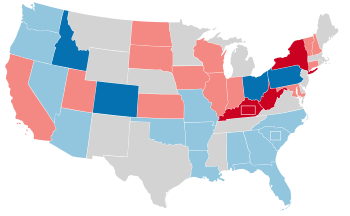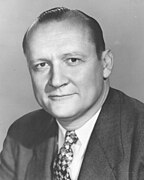| ||||||||||||||||||||||||||||||||||||||||
35 of the 96 seats in the United States Senate 49 seats needed for a majority | ||||||||||||||||||||||||||||||||||||||||
|---|---|---|---|---|---|---|---|---|---|---|---|---|---|---|---|---|---|---|---|---|---|---|---|---|---|---|---|---|---|---|---|---|---|---|---|---|---|---|---|---|
| ||||||||||||||||||||||||||||||||||||||||
 | ||||||||||||||||||||||||||||||||||||||||
| ||||||||||||||||||||||||||||||||||||||||
The 1956 United States Senate elections were elections for the United States Senate that coincided with the re-election of President Dwight D. Eisenhower. The 32 seats of Class 3 were contested in regular elections, and three special elections were held to fill vacancies. Although Democrats gained two seats in regular elections, the Republicans gained two seats in special elections, leaving the party balance of the chamber unchanged.
Democrats defeated incumbents Herman Welker (R-Idaho), George H. Bender (R-Ohio), and James H. Duff (R-Pennsylvania), as well as winning a Republican-held seat in Colorado. Republicans defeated incumbent Earle C. Clements (D-Kentucky) as well as winning Democratic-held seats in Kentucky, New York, and West Virginia. Thus, this election caused Kentucky's Senate delegation to flip from two Democrats to two Republicans.
During the next Congress, Republican John D. Hoblitzell Jr. was appointed to the seat of deceased Senator Matthew M. Neely (D-WV), while Democrat William Proxmire won a special election for the seat of deceased Senator Joseph McCarthy (R-Wisconsin). Also, Democrat Ralph Yarborough won a special election for the seat of Price Daniel (D-Texas), who had resigned from the Senate after being elected Governor of Texas. The net result was to leave the party balance unchanged. Republicans would not win a Senate in West Virginia again until 2014.
Cite error: There are <ref group=lower-alpha> tags or {{efn}} templates on this page, but the references will not show without a {{reflist|group=lower-alpha}} template or {{notelist}} template (see the help page).

